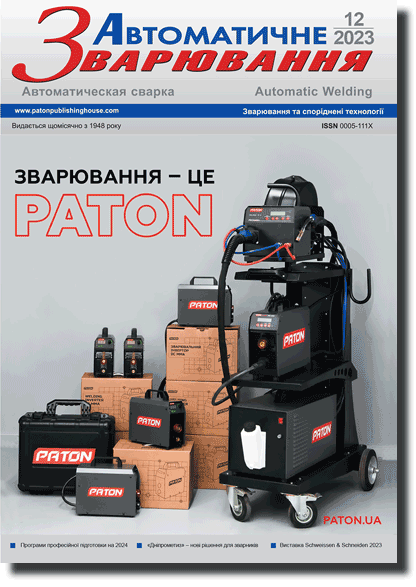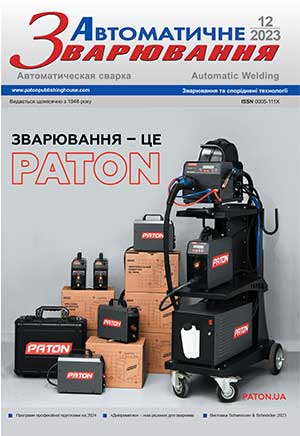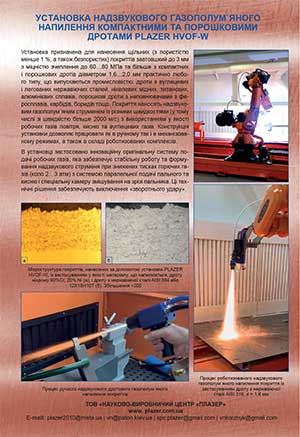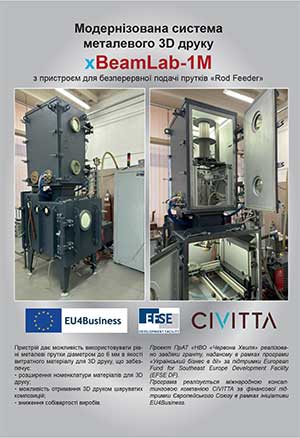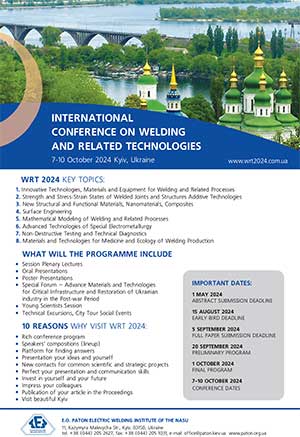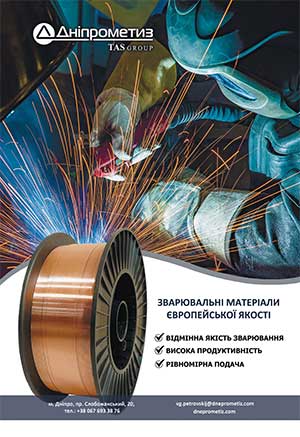| 2023 №12 (08) |
DOI of Article 10.37434/as2023.12.09 |
2023 №12 (01) |
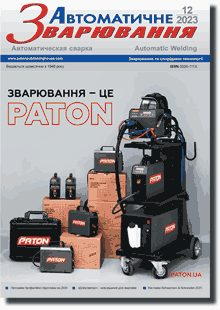
"Avtomatychne Zvaryuvannya" (Automatic Welding), #12, 2023, pp. 58-65
Hygienic assessment of fumes in flash-butt welding
O.G. Levchenko1, O.V. Demetska2, YU.O. Polukarpov1, O.M. Honcharova3, O.M. Bezushko3, N.A. Prakhovnik1, O.S. Ilchuk1, I.M. Andrusyshyna4
1National Technical University of Ukraine «Igor Sikorsky Kyiv Polytechnic Institute». 37 Prospect Beresteisky. E-mail@kpi.ua2Shupik Nationаl Health Care University of Ukraine. 9 Dorohozhytska Str., Kyiv, 04112, Ukraine. E-mail: dalexandra@ukr.net
3E.O. Paton Electric Welding Institute of the NAS of Ukraine. 11 Kazymyr Malevych Str., 03150, Kyiv, Ukraine. E-mail: office@paton.kiev.ua
4SC «Kundiev Institute of Occupational Health of the National Academy of Medical Sciences of Ukraine». 75 Saksaganskogo Str., Kyiv, 01033. E-mail: andrusyshyna.in@gmail.com
The objective of the paper is investigation of hygienic characteristics of harmful substances, which contaminate the air in continuous and pulsed flash-butt welding, to create the appropriate means for welder protection. Description of the methods of studying the chemical composition of welding fumes and gases, dispersed composition of the fumes and assessment of their influence on the welder body is given. It is found that flash-butt welding of R65 rails is accompanied by evolution of harmful substances into the working zone air in the form of fumes at the nanorange level, which are characterized by high biological activity. It is shown that fume toxicity at continuous and pulsed flashing belongs to a moderately dangerous class. The main elements, which determine the fume toxicity, are manganese and iron. It is found that in flash-butt welding the fumes are generated, which contain nanosized components of manganese and iron in concentrations, exceeding the calculated tentatively safe levels of human exposure. Performed studies showed that flash-butt welding is accompanied by generation of such toxic gases as nitrogen dioxide and carbon monoxide in the work place, in concentrations exceeding the limit permissible ones. Obtained results of comprehensive hygienic assessment of the fumes in flash-butt welding provided exhaustive information on the level of harmful influence of these fumes on the welder body. Ref. 20, Tabl. 5, Fig. 11.
Keywords: flash-butt welding, fumes, gases, dimensions, nanosized particles, recommendations
Received: 05.10.2023
References
1. Kuchuk-Yatsenko, S.I. (2018) Technologiesand equipment for flash-butt welding of rails: 60 years of continuous innovations. The Paton Welding J., 11-12, 25-40. https://doi.org/10.15407/as2018.12.032. Gubenya, I.P., Yavdoshchin, I.R., Stepanyuk, S.N., Demetskaya, A.V. (2014) Towards the problem of dispersity and morphology of particles in welding aerosols. The Paton Welding J., 6-7, 155-158. https://doi.org/10.15407/tpwj2014.06.34
3. Berlinger, B., Benker, N., Weinbruch, S. et al. (2010) Physicochemical characterization of different welding aerosols. Anal Bioanal Chemistry, 10, 1773-1789. https://doi.org/10.1007/s00216-010-4185-7
4. Leonenko, N.S., Demetska, O.V., Leonenko, O.B. (2016) Specifics of physico-chemical peculiarities and toxic impact of nanomaterials - to problem of assessment of their harmful influence on living bodies ( Literature review). Suchasni Problemy Toksykologii, Kharchovoi ta Khimichnoi Bezpeky, 1, 64-76 [in Russian].
5. Lewinski, N., Colvin, V., Drezek, R. (2008) Cytotoxicity of Nanoparticles. Small-journal, 1, 26-49. https://doi.org/10.1002/smll.200700595
6. Kundiev, Yu.I., Korda, M.M., Kashuba, M.O., Demetska, O.V. (2015) Toxicology of fumes. TDMU Ukrmedknyga [in Ukrainian].
7. Tanneberger, J.F.W.G. (2009) Schweiβrauch am Arbeitsplatz - Gefahr für die Gesundheit. Der Praktiker, 9, 328.
8. Jenkins, N.T., Pierce, W.M.G., Eagar, T.W. (2005) Particle size distribution of gas metal and flux cored arc welding fumes. Welding Journal, 84, 156-163.
9. Hoet, P.H.M., Bruеske-Hohlfeld, I., Salata, O.V. (2004) Nanoparticles - known and unknown health risks. Journal of Nanobiotechnology, 2. https://doi.org/10.1186/1477-3155-2-12
10. Patel, R.J., Alexander, A., Puri, A., Chatterjee, B. (2021) Current Challenges and Future Needs for Nanotoxicity and Nanosafety Assessment. Nanotechnology in Medicine: Toxicity and Safety, 299-314. https://doi.org/10.1002/9781119769897.ch14
11. Cena, L.G., Chisholm, W.P., Keane, M.J., Chen, B.T. (2015) A Field Study on the Respiratory Deposition of the Nano-Sized Fraction of Mild and Stainless Steel Welding Fume Metals. Journal of occupational and environmental hygiene, 12(10), 721-728. https://doi.org/10.1080/15459624.2015.1043055
12. Elder, A., Gelein, R., Silva, V. et al. (2006) Translocation of inhaled ultrafine manganese oxide particles to the central nervous system. Environmental health perspectives, 114(8), 1172-1178. https://doi.org/10.1289/ehp.9030
13. Leonenko, O.B., Leonenko, N.S., Movchan, V.O., Lukyanenko, A.O. (2018) Cytotoxicity of nanoparticles of welding fumes (Literature review). Suchasni Problemy Toksykologii, Kharchovoi ta Khimichnoi Bezpeky, 1, 25-38 [in Ukrainian]. https://doi.org/10.33273/2663-4570-2018-81-1-25-38
14. DSTU ISO 15011-4:2008 (2011) Health and safety in welding and related processes. Laboratory method of sampling fumes and gases. Pt 4. Form for recording data on aerosols. Kyiv, Derzhspozhyvstandard of Ukraine [in Ukrainian].
15. Movchan, V.O., Salnikova, N.A., Andrusyshina, I.M. et al. (2012) Method of identification of nanoparticles in air of working area. Patent of Ukraine on utility model No. 72951 of 10.09.2012 [in Ukrainian]. https://uapatents.com/4-72951-sposib-viznachennya-nanochastinok-v-povitri-robocho-zoni.html
16. PD 6699-2:2007 (2007) Nanotechnologies - Part 2: Guide to safe handling and disposal of manufactured nanomaterials. BSI-British Standards.
17. Kundiev, Yu.I., Trakhtenberg, I.M., Yavorskyi, O.P. et al. (2016) Hygienic regulation and control of nanomaterials in working environment. Procedural recommendations of NAMU [in Ukrainian].
18. (2020) Hygienic regulations of chemical substances in air of working environment. No. 1596 of 14.07.2020 [in Ukrainian].
19. Levchenko, O.G. (2015) Welding fumes and gases: Formation processes, method of neutralization and means of protection. Kyiv Naukova Dumka [in Russian].
20. Levchenko, O., Polukarov, Y., Goncharova, O. et al. (2022) Determining patterns in the generation of magnetic fields when using different contact welding techniques. Eastern-European Journal of Enterprise Technologies, 6 (10(120), 46-53. https://doi.org/10.15587/1729-4061.2022.268699
Advertising in this issue:
The cost of subscription/purchase order journals or individual articles
| Journal/Currency | Annual Set | 1 issue printed |
1 issue |
one article |
| TPWJ/USD | 384 $ | 32 $ | 26 $ | 13 $ |
| TPWJ/EUR | 348 € | 29 € | 24 € | 12 € |
| TPWJ/UAH | 7200 UAH | 600 UAH | 600 UAH | 280 UAH |
| AS/UAH | 1800 UAH | 300 UAH | 300 UAH | 150 UAH |
| AS/USD | 192 $ | 32 $ | 26 $ | 13 $ |
| AS/EUR | 180 € | 30 € | 25 € | 12 € |
| SEM/UAH | 1200 UAH | 300 UAH | 300 UAH | 150 UAH |
| SEM/USD | 128 $ | 32 $ | 26 $ | 13 $ |
| SEM/EUR | 120 € | 30 € | 25 € | 12 € |
| TDNK/UAH | 1200 UAH | 300 UAH | 300 UAH | 150 UAH |
| TDNK/USD | 128 $ | 32 $ | 26 $ | 13 $ |
| TDNK/EUR | 120 € | 30 € | 25 € | 15 € |
AS = «Automatic Welding» - 6 issues per year;
TPWJ = «PATON WELDING JOURNAL» - 12 issues per year;
SEM = «Electrometallurgy Today» - 4 issues per year;
TDNK = «Technical Diagnostics and Non-Destructive Testing» - 4 issues per year.





